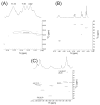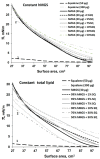Surface Properties of Squalene/Meibum Films and NMR Confirmation of Squalene in Tears
- PMID: 26370992
- PMCID: PMC4613282
- DOI: 10.3390/ijms160921813
Surface Properties of Squalene/Meibum Films and NMR Confirmation of Squalene in Tears
Abstract
Squalene (SQ) possesses a wide range of pharmacological activities (antioxidant, drug carrier, detoxifier, hydrating, emollient) that can be of benefit to the ocular surface. It can come in contact with human meibum (hMGS; the most abundant component of the tear film lipid layer) as an endogenous tear lipid or from exogenous sources as eyelid sebum or pharmaceuticals. The aims of this study were to determine (i) if SQ is in tear lipids and (ii) its influence on the surface properties of hMGS films. Heteronuclear single quantum correlation NMR confirmed 7 mol % SQ in Schirmer's strips extracts. The properties of SQ/hMGS pseudo-binary films at the air/water interface were studied with Langmuir surface balance, stress-relaxation dilatational rheology and Brewster angle microscopy. SQ does not possess surfactant properties. When mixed with hMGS squalene (i) localized over the layers' thinner regions and (ii) did not affect the film pressure at high compression. Therefore, tear SQ is unlikely to instigate dry eye, and SQ can be used as a safe and "inert" ingredient in formulations to protect against dry eye. The layering of SQ over the thinner film regions in addition to its pharmacological properties could contribute to the protection of the ocular surface.
Keywords: Langmuir trough; NMR; meibum; sebum; squalene; tear film.
Figures








Similar articles
-
Surface Chemistry Interactions of Cationorm with Films by Human Meibum and Tear Film Compounds.Int J Mol Sci. 2017 Jul 18;18(7):1558. doi: 10.3390/ijms18071558. Int J Mol Sci. 2017. PMID: 28718823 Free PMC article.
-
Sebum/Meibum Surface Film Interactions and Phase Transitional Differences.Invest Ophthalmol Vis Sci. 2016 May 1;57(6):2401-11. doi: 10.1167/iovs.16-19117. Invest Ophthalmol Vis Sci. 2016. PMID: 27145473 Free PMC article.
-
Confirmation of the presence of squalene in human eyelid lipid by heteronuclear single quantum correlation spectroscopy.Lipids. 2013 Dec;48(12):1269-77. doi: 10.1007/s11745-013-3844-9. Epub 2013 Oct 1. Lipids. 2013. PMID: 24081494
-
Dynamic interfacial properties of human tear-lipid films and their interactions with model-tear proteins in vitro.Adv Colloid Interface Sci. 2016 Jul;233:4-24. doi: 10.1016/j.cis.2015.12.009. Epub 2015 Dec 23. Adv Colloid Interface Sci. 2016. PMID: 26830077 Review.
-
The real reason for having a meibomian lipid layer covering the outer surface of the tear film - A review.Exp Eye Res. 2015 Aug;137:125-38. doi: 10.1016/j.exer.2015.05.002. Epub 2015 May 14. Exp Eye Res. 2015. PMID: 25981748 Review.
Cited by
-
Surface Chemistry Interactions of Cationorm with Films by Human Meibum and Tear Film Compounds.Int J Mol Sci. 2017 Jul 18;18(7):1558. doi: 10.3390/ijms18071558. Int J Mol Sci. 2017. PMID: 28718823 Free PMC article.
-
Mechanisms, imaging and structure of tear film breakup.Ocul Surf. 2018 Jan;16(1):4-30. doi: 10.1016/j.jtos.2017.09.007. Epub 2017 Sep 20. Ocul Surf. 2018. PMID: 28935579 Free PMC article. Review.
-
Human meibum chain branching variability with age, gender and meibomian gland dysfunction.Ocul Surf. 2019 Apr;17(2):327-335. doi: 10.1016/j.jtos.2018.12.005. Epub 2018 Dec 12. Ocul Surf. 2019. PMID: 30553000 Free PMC article.
-
Structural Differences in Meibum From Donors After Hematopoietic Stem Cell Transplantations.Cornea. 2019 Sep;38(9):1169-1174. doi: 10.1097/ICO.0000000000001935. Cornea. 2019. PMID: 31261179 Free PMC article.
-
Surface properties and exponential stress relaxations of mammalian meibum films.Eur Biophys J. 2017 Mar;46(2):129-140. doi: 10.1007/s00249-016-1146-x. Epub 2016 Jun 21. Eur Biophys J. 2017. PMID: 27324905
References
-
- Green-Church K.B., Butovich I., Willcox M., Borchman D., Paulsen F., Barabino S., Glasgow B.J. The international workshop on meibomian gland dysfunction: Report of the subcommittee on tear film lipids and lipid-protein interactions in health and disease. Investig. Ophthalmol. Vis. Sci. 2011;52:1979–1993. doi: 10.1167/iovs.10-6997d. - DOI - PMC - PubMed
-
- Holly F.J. Physical chemistry of the normal and disordered tear film. Trans. Ophthalmol. Soc. UK. 1985;104:374–380. - PubMed
Publication types
MeSH terms
Substances
LinkOut - more resources
Full Text Sources
Other Literature Sources
Medical

